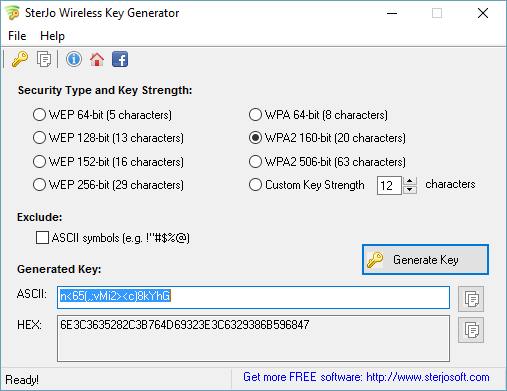256 Bit Random Key Generator
WPA PSK (Raw Key) Generator
The Wireshark WPA Pre-shared Key Generator provides an easy way to converta WPA passphrase and SSID to the 256-bit pre-shared ('raw') key used for keyderivation.

Directions:
Type or paste in your WPA passphrase and SSID below. Wait awhile. The PSK will be calculated by your browser. Javascriptisn't known for its blistering crypto speed. None of thisinformation will be sent over the network. Run a trace with Wireshark ifyou don't believe us.
Strong Password Generator to create secure passwords that are impossible to crack on your device without sending them across the Internet, and learn over 30 tricks to keep your passwords, accounts and documents safe. Random Key Generator for Passwords, Encryption Keys, WPA Keys, WEP Keys, CodeIgniter Keys, Laravel Keys, and much more. Don't got what you're looking for! Send us a mail or contribute on Github. KeyGen.io - Random Key Generators. Decent Password. Strong Password. WPA 504-bit Key. WEP 64-bit Key.
This page uses pbkdf2.js by Parvez Anandam andsha1.js by Paul Johnston.
I have a lot of traffic..
- Why is OpenSSL generated 256-bit AES key 64 characters in length? Ask Question Asked 3 years, 5 months ago. A 256-bit key should be 41 characters in length after base64 encoding. Am I missing something obvious here? How to generate a random integer array satisfying complex constraints.
- Probably the best way is to use PBKDF2 using SHA256 (which will generate 256 bit output) and a application specific salt & iteration count. You should be aware that using an application specific salt removed quite a lot of the protection from PBKDF2, so you.
ANSWER: SteelCentral™ AppResponse 11
- • Full stack analysis – from packets to pages
- • Rich performance metrics & pre-defined insights for fast problem identification/resolution
- • Modular, flexible solution for deeply-analyzing network & application performance
Creating and managing keys is an important part of the cryptographic process. Symmetric algorithms require the creation of a key and an initialization vector (IV). The key must be kept secret from anyone who should not decrypt your data. The IV does not have to be secret, but should be changed for each session. Asymmetric algorithms require the creation of a public key and a private key. The public key can be made public to anyone, while the private key must known only by the party who will decrypt the data encrypted with the public key. This section describes how to generate and manage keys for both symmetric and asymmetric algorithms.
Symmetric Keys
The symmetric encryption classes supplied by the .NET Framework require a key and a new initialization vector (IV) to encrypt and decrypt data. Whenever you create a new instance of one of the managed symmetric cryptographic classes using the parameterless constructor, a new key and IV are automatically created. Anyone that you allow to decrypt your data must possess the same key and IV and use the same algorithm. Generally, a new key and IV should be created for every session, and neither the key nor IV should be stored for use in a later session.
To communicate a symmetric key and IV to a remote party, you would usually encrypt the symmetric key by using asymmetric encryption. Sending the key across an insecure network without encrypting it is unsafe, because anyone who intercepts the key and IV can then decrypt your data. For more information about exchanging data by using encryption, see Creating a Cryptographic Scheme.
The following example shows the creation of a new instance of the TripleDESCryptoServiceProvider class that implements the TripleDES algorithm.
When the previous code is executed, a new key and IV are generated and placed in the Key and IV properties, respectively.
Sometimes you might need to generate multiple keys. In this situation, you can create a new instance of a class that implements a symmetric algorithm and then create a new key and IV by calling the GenerateKey and GenerateIV methods. The following code example illustrates how to create new keys and IVs after a new instance of the symmetric cryptographic class has been made.

When the previous code is executed, a key and IV are generated when the new instance of TripleDESCryptoServiceProvider is made. Another key and IV are created when the GenerateKey and GenerateIV methods are called.
Asymmetric Keys
The .NET Framework provides the RSACryptoServiceProvider and DSACryptoServiceProvider classes for asymmetric encryption. These classes create a public/private key pair when you use the parameterless constructor to create a new instance. Asymmetric keys can be either stored for use in multiple sessions or generated for one session only. While the public key can be made generally available, the private key should be closely guarded.
A public/private key pair is generated whenever a new instance of an asymmetric algorithm class is created. After a new instance of the class is created, the key information can be extracted using one of two methods:
The ToXmlString method, which returns an XML representation of the key information.
The ExportParameters method, which returns an RSAParameters structure that holds the key information.
Both methods accept a Boolean value that indicates whether to return only the public key information or to return both the public-key and the private-key information. An RSACryptoServiceProvider class can be initialized to the value of an RSAParametersCall of duty modern warfare 3 key code generator. structure by using the ImportParameters method.
Asymmetric private keys should never be stored verbatim or in plain text on the local computer. If you need to store a private key, you should use a key container. For more on how to store a private key in a key container, see How to: Store Asymmetric Keys in a Key Container.
The following code example creates a new instance of the RSACryptoServiceProvider class, creating a public/private key pair, and saves the public key information to an RSAParameters structure.